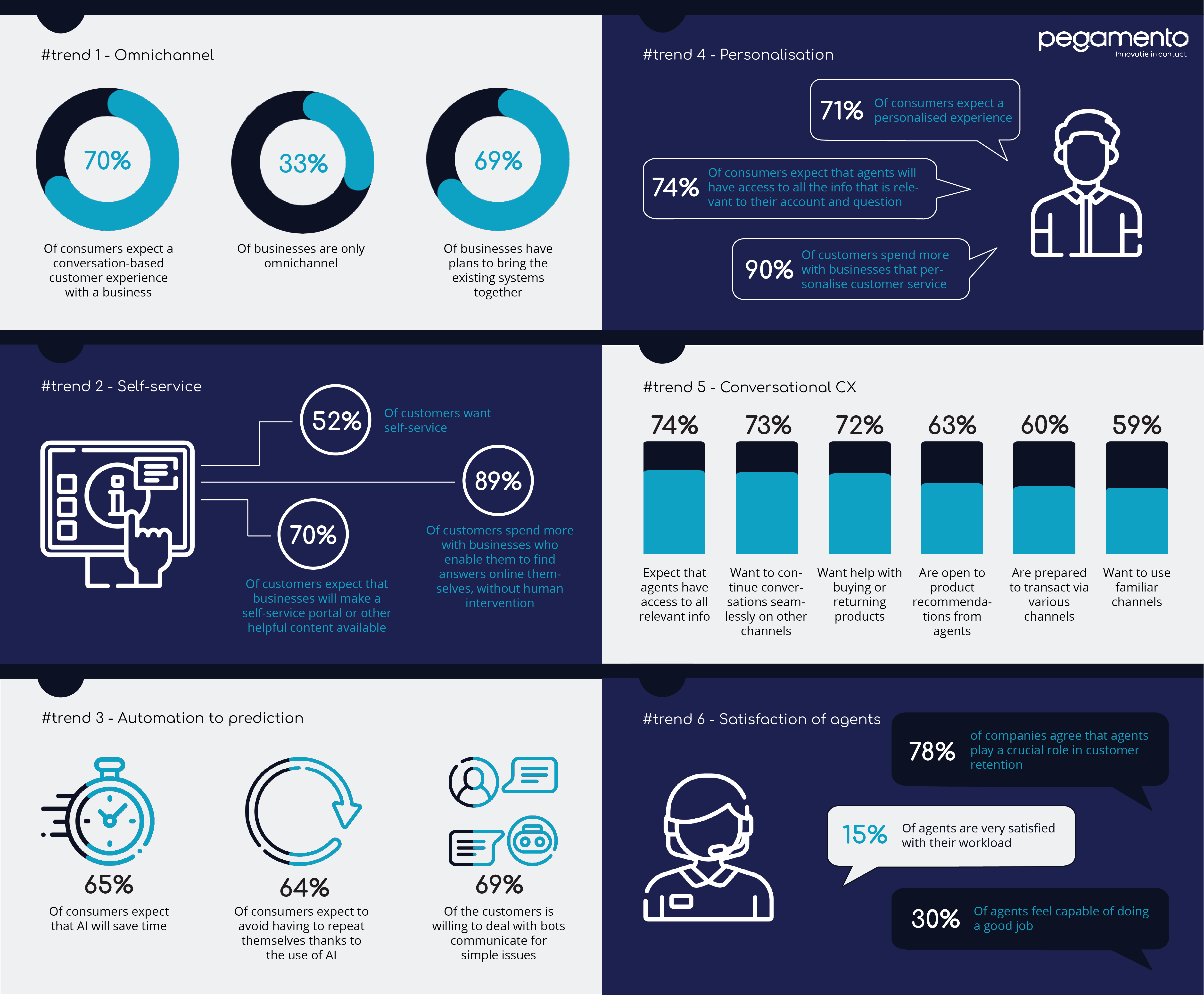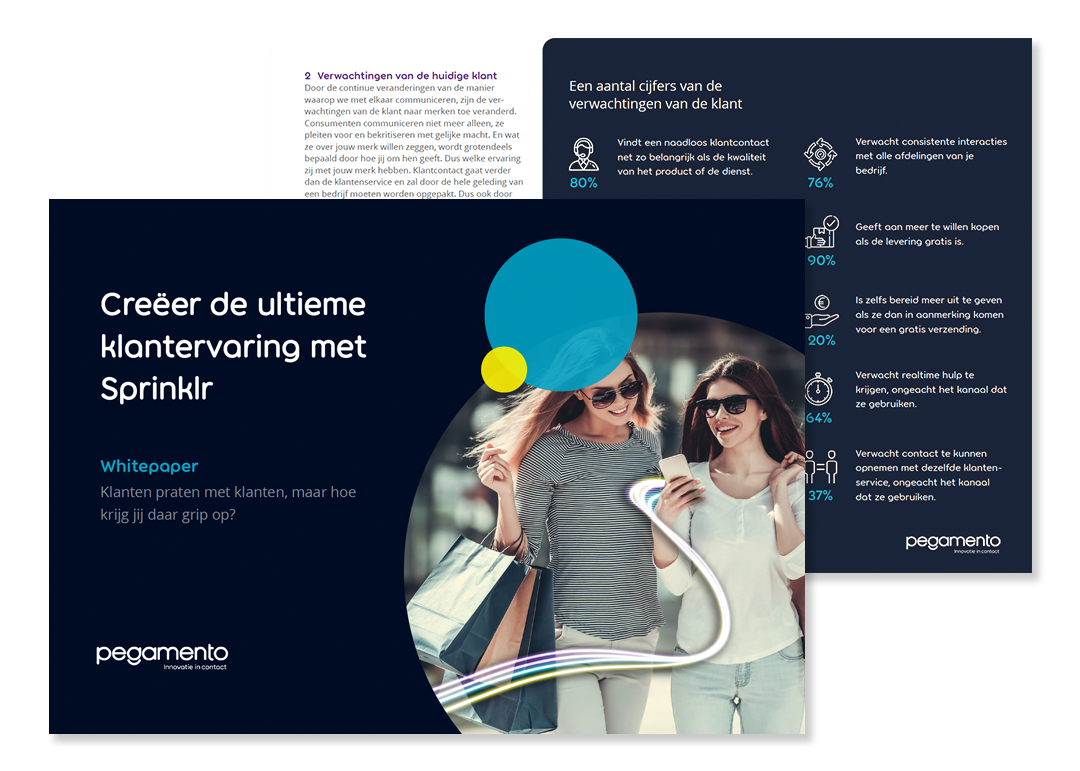We already mentioned this in the customer contact trends of 2022: customers want both the best service and personal contact. And this is even more so in 2023. Partly due to the crisis in recent years, customers have raised the bar for customer service. They are now more likely to switch to a competitor after just one bad experience. Thanks to all the changes, such as increased use of digital channels due to the pandemic and developments in technology, customer contact trends have not stood still. We did the research for you, and these are the 6 customer contact trends we uncovered for 2023:

Trend 1: Seamless omnichannel approach
It probably hasn't escaped your notice that customers are contacting your organisation via an increasing number of (digital) channels and that they expect you to be active on their preferred channel. They assume they can switch channels at any time without having to repeat themselves when they contact your organisation on a subsequent occasion. Customers choose for themselves whether to contact a company physically, via a traditional channel, or digitally. Regardless of the channel they choose, customers expect a conversational and consistent customer experience. A good omnichannel approach here ensures a seamless customer experience across multiple (digital) channels.
A good example here is Thuisbezorgd.nl. You order food from one of your favourite restaurants in the app. After ordering, you are sent a waiting time and you receive updates when your food is being prepared, when it is ready, and when it is about to be delivered. The food is delivered by your chosen restaurant, and a few hours later you automatically receive an email from Thuisbezorgd.nl asking you about your experience of the food and service. In this example, all the contact moments and channels work together seamlessly.
As the boundaries between physical and digital experiences blur, customers are becoming less forgiving towards companies that do not have proper omnichannel service in place. That is why more and more organisations are deploying a seamless omnichannel approach, allowing communication channels to flow seamlessly into one other.
Also read: The perfect omnichannel strategy in 5 steps
Trend 2: Self-service
Self-service is a predominant and growing customer expectation. According to CXNetwork's Global State of Customer Experience 2022 report, 52% of customers want self-service. This allows them to quickly find answers to questions and problems themselves, without having to contact customer service. Examples of self-service options include a knowledge base, community forums, and FAQs.
The preference for self-service has grown due to increased waiting times on the phone if a customer wants to speak to a customer service representative. It turns out that we just don't like waiting. It is not that customers would rather not speak to a human employee, but rather that self-service is now widely recognised as a faster and easier route to obtaining the desired support.
It offers companies a unique opportunity to improve customer service while reducing the cost of and pressure on support staff. Self-service can result in shorter queues on the phone and customers accessing the information they need more quickly.
Trend 3: From automation to prediction
The concepts of technologies such as Robotic Process Automation (RPA) and Artificial Intelligence (AI) within customer service are not new. In the past two years, these technologies have become an essential part of a successful customer experience strategy. In particular, they are applied to providing self-service through AI chatbots and/or reducing employee workload by automating tasks.
Technology can, for example, be used to automate employee tasks, predict customer behaviour, scale up customer service, and improve customer experience. Companies implement, among others, the following technologies in their customer service:
- AI chatbots to answer simple customer questions and handle customer interactions without intervention by an agent
- RPA to retrieve customer data, automate simple tasks, and enter data into the right systems
- AI to analyse data and make suggestions to provide proactive customer service, as well as to understand patterns in customer behaviour and to recognise emotion
- A combination of both to initiate (automatic) workflows, create a 360-degree customer view, and offer 24/7 customer service
Customers see companies' use of artificial intelligence, in particular, in a positive light. 65% expect AI to save them time and 64% expect not to have to repeat themselves. All in all, robotisation can put a positive spin on customer contact, with the aim of providing an even better customer experience for your customers.
Also read: which processes, exactly, you can robotise with RPA
Trend 4: Personalisation in the customer experience
From McKinsey's 2021 Next in Personalisation report, 71% of consumers expect a personalised experience. Using various technologies, such as artificial intelligence, employees can analyse customer behaviour based on previous queries or service requests. They can also use these technologies to research what resonates with the target audience. Using this data, you can accurately respond to your customers' needs and personalise the customer experience. Or you can even create the need.
This allows you to provide proactive service. You then anticipate problems instead of reacting to them. It's about finding solutions to problems that customers don't know they have. You inform the customer about things you think they are interested in before they have asked about them, so to speak.
Customers expect all experiences to be personalised. In fact, it turns out that 90% of customers will spend more money with a business that personalises customer service. This presents you with a great opportunity. Netflix, for example, personalises your account. Using AI models, they map your viewing behaviour and show you series and videos that most closely match your interests.
Trend 5: Conversational CX
Consumer spending growth is expected to slow in 2023. Most customers are feeling the pressure of inflation and an impending recession. Non-essential spending will decline, meaning every experience matters. Brands need to show empathy and build relationships for the future.
This is where conversational CX comes in. What is meant by this? It is the process of interacting with customers by way of a natural conversation at any point in their purchase journey. It aims to simplify every interaction between customer and organisation, from marketing to customer service and everything in between. The aim is to provide an ultimate customer experience to (potential) customers.
Communication between the customer and the organisation should be effortless. At its core, conversational CX is about convenience in the customer journey. It should be used to provide convenience to customers at every step of their customer journey. The entire process should be made simple and intuitive. The customer should not be treated as a stranger and should be able to contact the organisation in a convenient way. Several surveys show that more than 60% of customers are now willing to switch to a competitor after just one bad experience.
Trend 6: Satisfaction of your agents
A company's revenue increasingly depends on the success of its service agents. A trend report found that 78% of companies agree that agents play a crucial role in customer retention. Only 15% of agents are extremely satisfied with their workload. And only 20% feel satisfied about the quality of the training they receive. Ultimately, less than 30% feel they are able to do a good job.
Customer satisfaction is affected by the entire organisation, but customer service plays the biggest role. Numerous studies have shown that happy people are better employees, and that they ensure a better customer experience. That is why more and more organisations are investing in their customer service staff, including better training and the right technological tools.
Using modern technology platforms, organisations can take repetitive tasks away from employees, reduce their workload, increase CSAT, and keep remote employees connected. Useful features such as ticket classification using AI and automatically routing incoming customer communication to the right person are things that save employees up to 1.2 hours a day. That gives them more time to do what they do best: make customers happy.
The customer contact trends in 2023 revolve around customer experience
How you deal with customers makes or breaks your organisation. This includes the way you care about them and how they talk about you to others. All trends revolve around meeting and even exceeding customer needs and expectations, and delivering an ultimate customer experience without putting pressure on service staff. If your organisation can do this, you generate competitive advantage. It is no longer about product or price, but about the surrounding customer experience. And this is what more and more companies are focusing on in their strategies.
The right start with a CX platform
Responding to the customer contact trends in 2023 and thus creating competitive advantage does not happen overnight. It starts with a central CX platform in which you can merge all channels, (customer) data, and operations, and in which all systems and employees can work together.
Sprinklr is one such platform. It is an all-in-one solution incorporating all the customer-facing functions, such as marketing, advertising, customer care, customer feedback management, sales, and engagement. This platform can handle 42 different customer contact channels and several languages. It also offers self-service tools, such as an integrated knowledge base, AI chatbots, and insights that enable continuous optimisation.
The platform uses more than 100 AI models that listen to everything online 24 hours a day. It is also fully GDPR compliant. Thanks to these AI algorithms, it is possible to harvest data and turn it into information that you can use to answer the questions: "What do people mean?", ''What do people struggle with in relation to our brand?", ''What resonates with our target audience?" and ''How do people experience the service, the brand?
In addition, it provides an overview of whether customers are satisfied or dissatisfied. When an agent is talking to a customer via chat or phone, the AI engine recognises the customer's emotional state based on words, tone-of-voice, and/or speech. All contact moments with an individual are recorded along with the data you already have about that person. This allows you to see what was previously discussed, requested, and/or ordered. Additionally, you can see the contact history, order history, and customer satisfaction, which collectively form the 360-degree customer view.
It includes all the aspects necessary to give your service staff, and all other departments within the organisation, the tools they need to respond to the customer contact trends in 2023 and to communicate in a tailored way: quickly, but personally, without an additional workload.
Want to know more about Sprinklr and what it can do for you? Contact one of our professionals with no obligation.
Create the ultimate customer experience with Sprinklr
Consumers are increasingly looking for convenience and good service. It is no longer just about product and price. How you interact with your customers makes or breaks your business. And your customers are only too happy to share their thoughts about your business with others. They talk to and about your brand via the channel of their choice. How should you handle this? Find out in the white paper.
Download the free white paper and create the ultimate customer experience for your organisation. In the white paper, you will also discover 7 ways to improve your customer experience strategy.


